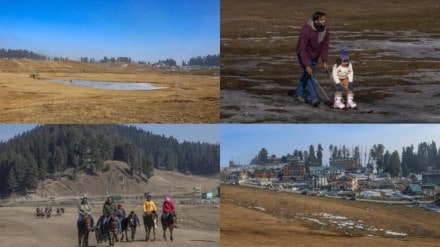Gulmarg, renowned for its winter charm and vibrant ski resorts, is grappling with an unusual winter predicament – a severe shortage of snow. This scarcity has not only deterred tourists but has also inflicted a significant blow to the local ski industry. According to government data from January last year, Gulmarg hosted 95,989 tourists, including 547 foreigners. While current figures for this month are yet to be released, officials estimate a staggering 60% decline in tourist footfall.
The region experienced a dire 79% rainfall deficit throughout December, leaving ski slopes barren. This weather anomaly has been attributed to the El Niño effect, characterized by heightened sea surface temperatures in the Pacific Ocean, disrupting global weather patterns and causing substantial reductions in snow and rainfall. But that’s not the only reason.
How does dry winters impact locals?
The absence of snow not only disappoints tourists and winter sports enthusiasts but also raises concerns about potential water scarcity and adverse impacts on local agriculture. Meteorological experts caution that the valley may face more frequent and prolonged droughts in the future, signaling a shift in climatic patterns with far-reaching consequences for the region’s ecosystem and economy.
The implications of reduced snowfall are both immediate and long-term. In the short term, the dry spell could elevate the risk of forest fires, trigger agricultural drought, and lead to a drop in crop production, the IE report quoted head of Srinagar IMD Mukhtar Ahmad as saying. An early spring may impact flowering and result in reduced yields, affecting vital components of the local economy, such as apples and saffron.
In the long term, the region faces challenges such as reduced hydroelectricity generation, accelerated glacier melting, and a potential threat to drinking water supply due to inadequate snowfall for groundwater recharge. Winter snow, crucial for maintaining soil moisture, is indispensable for winter crops, particularly horticulture.
Impact of Western disturbances on precipitation
Winter precipitation in the Himalayan region is chiefly influenced by Western disturbances – expansive eastward-moving rain-bearing wind systems originating beyond Afghanistan and Iran. These disturbances gather moisture from as far as the Mediterranean Sea and the Atlantic Ocean. According to a report by The Indian Express, recent studies highlighted a concerning decline in the mean frequency of strong and extreme Western disturbances, indicating a 43% decrease in events resulting in significant rainfall or snowfall.
El Niño effect
Meteorologists point to the persistent El Niño phenomenon as a potential aggravator of the current weather situation. Elevated sea surface temperatures due to El Niño have disrupted global atmospheric circulation, contributing to deficient precipitation in the region. While not the sole reason for the decline, El Niño appears to be compounding the challenges faced by Gulmarg this winter, IE reported.
